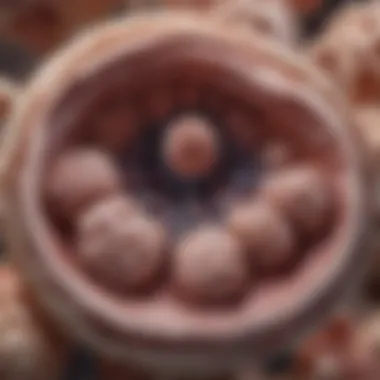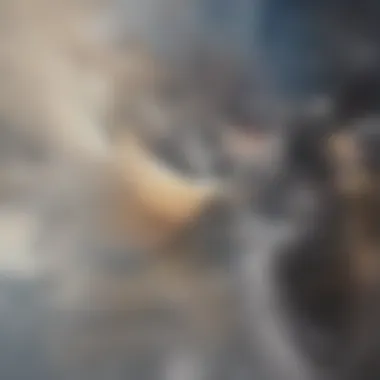Centrilobular Nodules Treatment: A Comprehensive Review


Intro
Centrilobular nodules are small, often benign lesions frequently identified through imaging in the lungs. They offer a complex challenge in diagnostics and treatment due to their varied etiology. Understanding these nodules involves an in-depth exploration of their causes, potential implications for lung health, and the available treatment options. The process requires a careful examination of imaging results, a nuanced understanding of underlying health conditions, and ongoing assessment to ensure optimal patient outcomes.
Often, these nodules can be associated with respiratory conditions, including chronic obstructive pulmonary disease (COPD) and certain forms of lung infections. However, they may also arise from more severe underlying conditions. In order to effectively treat these lesions, practitioners must differentiate between benign and malignant conditions through rigorous diagnostic protocols.
This review provides valuable insights into the current understanding and management strategies for centrilobular nodules. It aims to equip healthcare professionals with the latest information in diagnosis and treatment to enhance patient care.
Key Findings
Summary of the Main Results
- Centrilobular nodules are commonly found in patients with chronic lung diseases.
- Advanced imaging techniques, such as CT scans, play a crucial role in identifying these nodules and determining their characteristics.
- Treatment options can range from routine monitoring to invasive procedures, depending on the diagnostic findings.
- An understanding of associated conditions is integral for developing a comprehensive treatment plan.
Significance of Findings Within the Scientific Community
The identification of centrilobular nodules contributes significantly to the early detection of serious health issues. The findings summarized here reflect the ongoing efforts in the medical community to refine diagnostic criteria and management protocols. Improved imaging technology has opened avenues for nuanced analysis, allowing practitioners to make informed decisions regarding treatment pathways.
Implications of the Research
Applications of Findings in Real-World Scenarios
The insights from this review can directly influence clinical practices. For instance, recognizing the distinct features of centrilobular nodules through detailed imaging can lead to more precise diagnoses. This capability enables healthcare providers to determine whether a nodule necessitates further investigation or immediate intervention. Additionally, understanding the risk factors associated with these nodules can also enhance preventative strategies in at-risk populations.
Potential Impact on Future Research Directions
Continued research into centrilobular nodules is essential. As our understanding deepens, future studies could explore new diagnostic markers or treatment methodologies. The evolution of imaging technology and its integration into everyday clinical practice will likely shape the future of lung health management significantly. Furthermore, as the medical field shifts toward personalized medicine, there is potential for tailored treatment approaches based on individual patient profiles and nodule characteristics.
Intro to Centrilobular Nodules
Centrilobular nodules are significant in the field of pulmonary health. They represent localized lesions commonly found within the lung region. Understanding these nodules is essential as they can provide insights into various underlying conditions. They often raise concerns during imaging procedures, making it crucial for both healthcare professionals and patients to be informed.
Definition and Characteristics
Centrilobular nodules are small radiographic findings situated in the center of lung lobules. They typically measure less than 1 centimeter and are prominently visible on imaging modalities, particularly chest X-rays and CT scans. These nodules can appear singular or multiple, and their presence may vary in density. The characteristics such as size, shape, and density are important for differential diagnosis. For instance, certain infectious diseases can lead to the formation of multiple centrilobular nodules, making it critical to correlate these radiographic findings with clinical history.
Importance of Understanding Nodules
Being aware of the nature and implications of centrilobular nodules empowers doctors to make better clinical decisions. These nodules are often benign, arising from various inflammatory processes. However, distinguishing between benign and malignant nodules remains a challenging task.
In terms of patient management, it is crucial to follow appropriate assessment protocols. This enhances the ability to recognize serious conditions that could require immediate treatment. Knowledge of centrilobular nodules is also relevant for forming preventive strategies and guiding research initiatives aimed at improving lung health.
Understanding centrilobular nodules is not just about recognizing a radiographic finding; it's about deciphering the broader health context.
Etiology of Centrilobular Nodules
Understanding the etiology of centrilobular nodules is crucial as it impacts both diagnosis and treatment strategies. These nodules can arise from a variety of pathological processes, and distinguishing their origins is necessary for effective clinical management. Knowledge of the different causes helps clinicians tailor treatment plans and enhances the potential outcomes for patients. Additionally, recognizing the etiology provides insight into potential long-term risks associated with certain conditions, guiding future monitoring and intervention strategies.
Common Causes
Centrilobular nodules frequently develop due to several commonly encountered factors. Among these, infections play a vital role. Conditions like tuberculosis and bacterial pneumonia can result in the formation of these nodules as the body's immune response mounts against infectious agents.
Moreover, inhalational injuries, often seen in individuals exposed to harmful substances over time, such as smoke or chemical fumes, can contribute to nodule development. Chronic inflammatory conditions, including sarcoidosis and hypersensitivity pneumonitis, are also significant contributors.
Another notable cause is neoplastic growth. Although benign, lesions such as granulomas or hamartomas can mimic the appearance of more serious pathologies. This highlights the necessity of accurate imaging and pathologic evaluation.
Some other common causes include:
- Chronic obstructive pulmonary disease (COPD)
- Cystic fibrosis
- Histoplasmosis
Rare and Complex Conditions
While common causes are vital to recognize, practitioners must also consider rare and complex conditions that can lead to centrilobular nodules. One critical example is alveolar proteinosis, a condition that results in the accumulation of proteinaceous material within the alveoli, leading to nodular formations detectable on imaging. Similarly, lung malignancies, particularly those presenting as solitary pulmonary nodules, often require careful evaluation to rule out metastatic disease.
Other lesser-known causes might include congenital lung malformations or systemic diseases like rheumatoid arthritis that can indirectly cause nodule formation due to resultant lung involvement.
Understanding both common and rare causes is indispensable for healthcare professionals as this knowledge lays the foundation for effective diagnosis, management, and subsequent treatment options.
Diagnostic Approaches


Understanding the diagnostic approaches for centrilobular nodules is essential. The role of accurate diagnosis in guiding treatment options cannot be overstated. Diagnostic methods provide critical insights into the nature, size, and possible causes of these nodules. When practitioners employ various imaging techniques, they can identify and characterize nodules effectively. This section explores the chief methods used in diagnosis, highlighting their strengths and limitations.
Imaging Techniques
CT Scans
CT scans are a pivotal tool in the diagnosis of centrilobular nodules. They offer high-resolution images of the thoracic structures. This enables clinicians to visualize the nodules clearly. The key characteristic of CT scans is their ability to provide detailed cross-sectional views of the lungs.
A major advantage of CT scans is their proficiency in detecting smaller nodules that might not be visible through other imaging methods. On the contrary, a disadvantage is the exposure to ionizing radiation; hence, their use should be justified based on clinical necessity. In summary, CT scans are invaluable when determining nodule characteristics and serving as a foundation for further investigations.
MRI
MRI, although less commonly used than CT for pulmonary assessment, serves specific roles. It excels in imaging soft tissue and vascular structures. The key characteristic of MRI is its non-ionizing nature, which makes it safer for repeated use. It is especially useful in evaluating complications or surrounding tissues.
However, MRIs tend to be more expensive and time-consuming than CT scans. The unique feature of MRI is its ability to provide functional information about lung tissues. While not frequently utilized for primary diagnosis, MRI can complement other methods when needed.
X-Rays
X-rays are a foundational imaging modality in lung assessment. They are generally the first step in imaging when nodules are suspected. The key characteristic of X-rays lies in their accessibility and speed. However, their resolution is not as high as that of CT scans.
X-rays can provide a quick overview of lung anatomy and detect larger nodules effectively. The uniqueness of X-rays is their wide availability and cost-effectiveness. Nevertheless, they may miss smaller nodules, making them insufficient for a comprehensive evaluation.
Histopathological Examination
Histopathological examination involves the analysis of tissue samples taken from lung nodules. This process provides definitive information about the nature of nodules. Examining samples under a microscope allows pathologists to differentiate between benign and malignant lesions. The unique component of histopathology is its ability to reveal cellular characteristics that influence treatment options.
Differential Diagnosis
Differential diagnosis is crucial when assessing centrilobular nodules. It involves distinguishing between various conditions that can present similarly. Conditions such as infections, malignancies, and granulomatous diseases must be considered. By utilizing imaging findings along with clinical data, healthcare providers can formulate a differential diagnosis. This step is vital in ensuring appropriate and timely management.
Treatment Options Overview
Understanding treatment options for centrilobular nodules is crucial in ensuring optimal care for patients. This section will outline the various pathways available, focusing on their specificity and effectiveness. Treatment strategies can encompass conservative management or surgical interventions. Each approach has its own merits and considerations, which healthcare providers must assess based on individual patient scenarios.
Effective management can significantly impact patient outcomes. Knowing when to initiate treatment, whether through monitoring or direct intervention, is key. Furthermore, being aware of patient comorbidities and preferences also guides the choice of treatment, ensuring overall well-being beyond just treating the nodules.
Conservative Management
Conservative management plays a vital role in the treatment of centrilobular nodules. This strategy often involves careful monitoring, allowing healthcare providers to observe changes over time before committing to more invasive treatments. There are several aspects within conservative management that warrant attention:
- Monitoring and Observation: This involves regular imaging studies and follow-ups to track the size and appearance of nodules. Depending on the initial findings, a watchful waiting approach can be both prudent and effective.
- Medications and Therapies: In certain cases, the use of medications may aid in symptom relief or address underlying causes. Common categories include:
- Antibiotics: Essential when a bacterial infection is suspected to contribute to nodule formation.
- Anti-inflammatories: These can help reduce inflammation and discomfort, thereby improving quality of life for some patients.
Surgical Interventions
When conservative management fails to yield satisfactory results, or if nodules exhibit aggressive characteristics, surgical interventions become necessary. Several considerations guide the decision to pursue surgical options:
- Indications for Surgery: Factors such as nodule size, growth rate, and the presence of symptoms indicate a more proactive approach. Not all nodules require surgical removal, thus careful evaluation is vital.
- Types of Surgical Procedures: The following procedures are frequently employed:
- Lobectomy: Involves the removal of a segment of the lung containing the nodule. It is more extensive and generally reserved for confirmed malignancies or other serious concerns.
- Wedge Resection: This is a less extensive procedure that targets only the nodule and a small margin of surrounding lung tissue. It may be preferable in cases where a lobectomy is deemed too drastic.
Ultimately, the choice between conservative and surgical options should be tailored to each patient's specific circumstances. Optimal care involves a nuanced understanding of the nodules, patient preferences, and ongoing assessment of treatment effectiveness.
Conservative Treatment Approaches
Conservative treatment approaches play a critical role in managing centrilobular nodules. These strategies focus on minimal intervention, prioritizing the body's natural healing mechanisms over invasive procedures. The advantages of conservative management include reduced risk of complications and procedural recovery time. These approaches are particularly relevant for cases where nodules show no significant growth or adverse symptoms. Understanding conservative treatments can enhance patient care and improve outcomes through careful monitoring and tailored therapeutic interventions.
Monitoring and Observation
Monitoring and observation are foundational aspects of conservative treatment. Regular imaging and assessments allow healthcare providers to track the size and characteristics of nodules over time. This vigilance helps in determining whether the nodules remain stable or present potential risks. Depending on the patients' symptoms and health status, doctors may recommend imaging follow-ups every three to six months. Such practices can aid in distinguishing benign nodules from those requiring further intervention, thereby ensuring timely and appropriate clinical responses without unnecessary interventions.
Medications and Therapies
Medications and therapies serve as two additional components of conservative management, offering options to address inflammation or infection that may accompany the nodules.
Antibiotics


Antibiotics can be particularly valuable in cases where a bacterial infection is involved. Their key characteristic is the ability to target and eliminate pathogens, potentially alleviating symptoms associated with infected nodules. Commonly prescribed antibiotics include amoxicillin and azithromycin, which are favorable choices because of their effectiveness and broad-spectrum coverage. The unique feature of antibiotics in the context of centrilobular nodules is their role in preventing the progression of infection-related complications. However, they should be prescribed judiciously to avoid the risk of developing antibiotic resistance, an issue that remains a concern in modern medicine.
Anti-inflammatories
Anti-inflammatories offer another approach to addressing issues related to centrilobular nodules. They help reduce inflammation, which can be critical when nodules are associated with inflammatory conditions. Non-steroidal anti-inflammatory drugs (NSAIDs), like ibuprofen, are popular due to their effectiveness in pain management and inflammation reduction. A unique feature of anti-inflammatories is their dual action; they can improve overall comfort while mitigating the body's inflammatory response. However, long-term use of these medications can lead to side effects such as gastrointestinal discomfort and increased risk of bleeding, making careful consideration of their long-term use vital.
"Conservative management provides a structured approach to dealing with centrilobular nodules, aiming for effective outcomes while minimizing risks associated with invasive procedures."
In summary, conservative treatment approaches combine monitoring and medication strategies to create a comprehensive management plan tailored to the patient's needs. This thoughtful balance helps ensure that patients receive optimal care while promoting natural healing.
Surgical Treatment Strategies
Surgical treatment strategies are crucial in addressing centrilobular nodules that are symptomatic or demonstrate concerning characteristics. Deciding on surgery often involves assessing the patient's overall health, the nature of the nodules, and the potential benefits and risks associated with the surgical procedures. There is a fine balance between the need for intervention and conservative management. Surgical options typically become relevant when nodules exhibit growth or characteristics that could suggest malignancy.
Indications for Surgery
Surgery is generally indicated under several circumstances. These include:
- Suspicion of malignancy: Nodules that exhibit irregular shapes, sizes greater than 1 cm, or growth over time often warrant surgical evaluation.
- Symptoms causing discomfort: Patients who experience significant respiratory symptoms that impact their quality of life may benefit from surgical intervention to remove problematic nodules.
- Failure of conservative management: In cases where nodules do not respond to medication or other conservative treatments, surgical options are considered.
Types of Surgical Procedures
There are two primary types of surgical procedures associated with centrilobular nodules: lobectomy and wedge resection.
Lobectomy
Lobectomy involves the removal of an entire lobe of the lung and is often performed when a larger lesion is suspected to be cancerous.
- Key Characteristic: Lobectomy is a definitive surgery designed to remove potential malignancy.
- Benefits: This procedure ensures that all surrounding tissue potentially affected by a tumor is also taken out, decreasing the chances of residual cancer.
- Unique Feature: Lobectomy also allows for thorough histopathological examination of the removed tissue, providing clinicians with valuable insights into further management.
- Advantages and Disadvantages: While lobectomy can be highly effective for large lesions, it also comes with risks such as decreased lung function post-surgery and longer recovery time.
Wedge Resection
Wedge resection entails the removal of a small, wedge-shaped section of the lung, including the nodule and a margin of healthy tissue.
- Key Characteristic: This procedure is less extensive than lobectomy and may be chosen for smaller lesions or when lung preservation is a priority.
- Benefits: Wedge resection can minimize impact on lung function while still addressing nodules of concern effectively.
- Unique Feature: The smaller size of wedge resection often results in quicker recovery times compared to larger lung resections.
- Advantages and Disadvantages: While this technique preserves more lung tissue, it might not adequately remove all cancerous cells if the lesion is larger or irregularly shaped, necessitating careful post-operative monitoring.
Special Populations and Considerations
Understanding the specific needs and challenges faced by special populations in relation to centrilobular nodules is critical. Certain groups may respond differently to treatment, necessitating tailored management strategies. Recognizing these unique considerations enhances patient outcomes and ensures careful monitoring. By addressing the needs of diverse populations, healthcare providers can create more effective treatment protocols.
Patients with Pre-existing Conditions
Patients with pre-existing conditions, such as chronic obstructive pulmonary disease (COPD) or asthma, present unique challenges in the management of centrilobular nodules. These individuals often have altered lung function, which can complicate both diagnosis and treatment. For instance, the presence of pre-existing lung diseases may inflate the risk of complications during surgical procedures.
Moreover, interpreting imaging results requires careful consideration of the existing lung pathology. A nodule on a background of chronic lung disease may reflect a different process than in a healthy lung. Therefore, a thorough understanding of the patient's medical history is vital. It guides clinicians in not only monitoring the nodules effectively but also in determining the appropriate therapeutic responses.
Additionally, pharmacological therapies used for pre-existing conditions should be reviewed. Some medications may have adverse interactions with therapies aimed at treating centrilobular nodules, which necessitates a careful assessment by healthcare providers.
Pediatric Considerations
Pediatric patients require attention to detail when dealing with centrilobular nodules. Children’s physiology differs significantly from adults, and they may present unique challenges. For example, the lung development and growth patterns in children are distinct, which necessitates distinct imaging interpretations and management strategies.
In children, low doses of radiation during imaging, like X-rays or CT scans, are important to limit exposure while achieving accurate diagnosis. Furthermore, treatment approaches should be geared towards minimizing long-term impacts on lung development. Surgical interventions may not be feasible in certain cases due to the size and growth of the child's lung.
It is also important to involve caregivers and educators in discussions about the child's health. Clear communication can help manage treatment plans and assist in regular follow-up care. An overall management strategy must emphasize a patient-centered approach, ensuring that both the patient’s and their family’s needs and concerns are addressed.
In addressing special populations, comprehensive strategies enhance treatment outcomes and promote better health overall.
Post-treatment Management
Post-treatment management of centrilobular nodules is crucial for ensuring the long-term health and well-being of patients. Since these nodules can arise from various underlying conditions, continuous monitoring helps in identifying any changes in their status. This section covers two key components: follow-up imaging and assessment, as well as long-term care strategies.
Follow-up Imaging and Assessment
Follow-up imaging is essential in evaluating the effectiveness of the chosen treatment. Regular imaging helps healthcare professionals determine if the nodules are stable, growing, or resolving. The preferred imaging techniques include CT scans and chest X-rays, which provide detailed insight into the size and structure of the nodules. The frequency and duration of follow-up imaging can vary based on the initial findings and the patient's overall health status.
Benefits of regular follow-up imaging include:


- Early detection of complications: Persistent or new nodules may indicate a change that warrants further investigation.
- Monitoring treatment effectiveness: Helps assess if the current management plan is producing the desired results.
- Patient reassurance: Regular check-ups can provide psychological comfort to patients, reducing anxiety regarding their condition.
Long-term Care Strategies
Long-term care strategies are vital for patients who have experienced treatment for centrilobular nodules. These strategies focus not only on monitoring but also on improving the overall lung health of patients. Specific components of long-term care strategies may include:
- Lifestyle modifications: Encouraging patients to adopt healthier habits, such as quitting smoking, regular physical activity, and a balanced diet, can significantly impact lung health.
- Education on symptoms: Patients should be informed about signs that may indicate potential complications, such as difficulty breathing, coughing up blood, or unexpected weight loss.
- Routine health checks: Encouraging patients to maintain regular appointments with healthcare providers fosters ongoing evaluation and timely intervention when necessary.
- Psychosocial support: Addressing the emotional and psychological aspects of dealing with lung health can facilitate better coping mechanisms and promote adherence to treatment plans.
"Ongoing management is not merely a follow-up; it’s a partnership between patient and provider that evolves with the individual's health journey."
Challenges in Treatment
The treatment of centrilobular nodules presents significant challenges that demand a nuanced understanding by healthcare professionals. These nodules may arise from a variety of etiologies, which influences their management strategies. Furthermore, complications stemming from surgical interventions and issues related to patient compliance can complicate effective treatment outcomes.
Complications of Surgical Procedures
Surgical interventions for centrilobular nodules can be essential but also carry inherent risks. Complications may include infections, bleeding, and possible damage to surrounding lung tissue. Additionally, a postoperative recovery period is necessary, which can introduce issues of its own.
- Infection: This is one of the most common complications after surgery. Proper sterile techniques and vigilant follow-up care are essential in minimizing the risk.
- Bleeding: While often manageable, excessive bleeding may necessitate further surgical intervention. It can complicate recovery and may lead to additional health issues.
- Damage to Lung Tissue: This can occur during procedures like lobectomy or wedge resection, where adjacent structures are susceptible to injury.
Understanding these risks can help in choosing the right surgical candidate and timing for the procedure. Moreover, detailed discussions with patients regarding these risks are crucial for informed consent.
Patient Compliance Issues
Patient compliance significantly impacts treatment efficacy and outcomes. Many factors influence a patient's ability to adhere to treatment regimens. For instance, understanding the nature of their condition and the necessity of their medications can enhance compliance.
- Educational Barriers: Patients often need comprehensive education about their condition and treatment plans. Inadequate understanding can result in non-compliance.
- Psychosocial Factors: Emotional stability plays a big role in a patient’s willingness to follow medical advice. Stress, depression, and anxiety can hinder compliance.
- Accessibility to Healthcare: For some patients, logistical issues such as transportation difficulties can lead to missed follow-up appointments or medication refills.
Overall, addressing the challenges of patient compliance can lead to better outcomes, particularly in long-term management of centrilobular nodules. Communication and support systems are vital in bridging the gap between treatment recommendations and patient adherence.
Future Directions in Research
Research into centrilobular nodules is integral for advancing treatment methodologies and improving patient outcomes. Current health trends show a growing interest in precision medicine and personalized therapies. By understanding the various underlying causes and pathways of centrilobular nodules, future studies can provide essential insights into effective treatment options and management strategies.
Emerging Therapies
Emerging therapies represent a significant shift in how centrilobular nodules may be treated. Traditional approaches primarily relied on conservative management and surgical intervention. However, recent advancements in molecular medicine and targeted therapies offer novel possibilities.
Benefits of Emerging Therapies:
- Targeted Treatments: New drug formulations can specifically address irregularities identified in nodules.
- Less Invasive Options: Some therapies could avoid traditional surgical methods entirely.
- Enhanced Efficacy: Tailored therapies might lead to better response rates for patients.
Research is ongoing to explore these avenues:
- Immunotherapy: Engaging the body’s immune system to fight aberrant cells.
- Biological Medications: Utilizing genetically engineered proteins that block the pathways leading to nodule development.
Healthcare providers must remain updated as these therapies advance through clinical trials and receive regulatory approval. The future looks promising as these options may redefine the treatment landscape.
Genetic Insights into Nodules
Genetic research is becoming increasingly relevant in understanding centrilobular nodules. Genetic predispositions may contribute to the formation of these lesions in certain individuals. Identifying genetic markers can potentially aid in the diagnosis and offer insights into treatment responses.
Considerations for Genetic Research:
- Identification of At-Risk Populations: Genetic testing may determine who is more susceptible to developing nodules.
- Personalized Medicine: Insights from genetic profiles may lead to customized treatment plans.
- Pathophysiological Insights: Understanding genetic links provides clarity on the mechanisms driving the formation of nodules.
Innovative studies aim to correlate genetic mutations with nodule characteristics. Findings from these studies will enhance predictive models used by healthcare professionals in both diagnosis and treatment, ultimately improving clinical outcomes for patients.
"A thorough understanding of genetic factors may pave the way for more tailored and effective interventions for individuals with centrilobular nodules."
Epilogue
In concluding this comprehensive review, it is essential to underscore the significance of understanding centrilobular nodules and their treatments. These nodules, while often benign, can be indicators of underlying pathologies that necessitate careful diagnosis and management. Clinicians must be equipped with the knowledge to differentiate between various causes, which can significantly affect treatment choices and outcomes. By recognizing the potential complications associated with both conservative and surgical approaches, healthcare professionals can optimize care pathways for patients.
Summary of Key Points
- Centrilobular nodules are typically detected through imaging techniques and can serve as crucial signifiers for pulmonary diseases.
- Diagnosis utilizes advanced imaging methods alongside histopathological examination to ensure accurate identification.
- Treatment options vary, with conservative management being appropriate in some cases, while surgical interventions may be necessary for more complex scenarios.
- Recognizing the needs of special populations, such as younger patients or those with pre-existing health issues, is critical for effective treatment.
- Ongoing post-treatment management is essential to monitor for recurrence and manage any long-term complications.
Final Thoughts on Centrilobular Nodules Treatment
The management of centrilobular nodules is a multifaceted process that requires continuous research and updated clinical practices. Awareness of emerging therapies is vital, as they offer new avenues for treatment, possibly improving patient outcomes significantly. Genetic insights into lung lesions can provide deeper understanding of their behavior and progression, guiding future therapeutic strategies.
In summary, as our knowledge evolves, it is crucial for medical professionals to remain adaptable, integrating new findings into their practice for the benefit of their patients. Continual learning and application of robust management strategies will enhance the effectiveness of treatment options available for centrilobular nodules.







